 |
|

|
 |
TABLE of CONTENTS
 |
Metro District uses Facebook Live feature as new way to engage public |
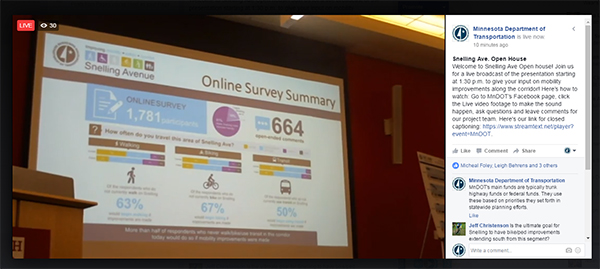
This screen shot from Facebook Live shows what online participants saw July 27 during MnDOT's open house for a preliminary bike/ped design on Snelling Avenue in St. Paul. Photo by Kristi Loobeek |
MnDOT held an open house at Hamline University in St. Paul on July 27 to discuss a preliminary design to improve the mobility, safety and comfort of walkers and bikers between the State Fair Grounds and Hamline University.
For the first time, the agency also broadcast the event – using Facebook’s new live video feature – which allowed online participants to see and hear the presentation in real-time from computers and mobile devices wherever they were, and to ask questions and provide input into the public process.
“This pairs a traditional face-to-face approach with online engagement, giving us one more tool to reach our diverse communities,” said Chris Krueger, Metro District communications and engagement director.
Krueger said about 20 people attended the open house in person, while the live broadcast attendance fluctuated between 30 and 40 people, reaching a peak of 43 people online.
“We reached far more people than expected,” said Mark Lindeberg, project manager.
Metro’s Communications and Engagement staffers Kevin Walker, Kirsten Klein, Josh Van Den Berg and Miranda Rice teamed with Lindeberg and consultant HDR to pull off the feat. MN.IT staff helped provide closed captioning to make the online meeting accessible to all.
“We’re pretty excited to broadcast live and use social media more for connecting and engaging with our audiences,” Krueger said.
|
 |
|

|
 |
TABLE of CONTENTS
 |
Buckle Up safety messages appear across state |
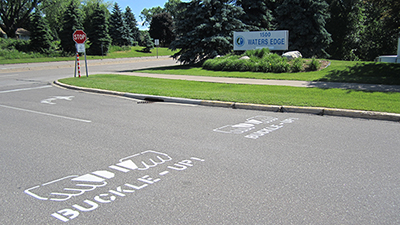
The Water’s Edge parklng lot exit in Roseville is one of the MnDOT locations that has a stenciled Buckle Up message. Photo by Susan Youngs |
Minnesotans got an extra reminder to wear their seat belts in May as stenciled Buckle Up messages appeared in parking lots across the state, including some MnDOT district locations.
The messaging efforts supported the May seat belt education and enforcement wave, which ran from May 23 through June 5. More than 300 law enforcement agencies participated in the annual extra enforcement effort and handed out 7,233 seat belt and 213 child restraint citations to those who risked losing their own lives or others in the car.
The messages appeared in such places as high schools and police departments, as Toward Zero Deaths stakeholders lent their painting skills toward seat belt safety.
In the TZD Southwest Region, the Kandiyohi Safe Communities Coalition coordinated more than 30 locations to paint the message. TZD regional coordinators together with their local TZD coalitions, distributed the stencils to as many places throughout Minnesota as possible.
“Anywhere people will let you paint the message, go ahead and paint it,” said Susan Youngs, Metro TZD regional coordinator. “That was my suggestion to our traffic safety partners in the Metro Region.”
MnDOT staff used their painting skills – displaying the message at the Water’s Edge exit and the Golden Valley and Oakdale truck stations – making this the first time the stencil was used at a MnDOT location.
This was due to Greg Coughlin, Metro’s director of maintenance and operations, who said, “I heard how the stencil was being used around the region, and I thought, ‘why aren’t we using it here?’”
Among the violations in the seat belt and enforcement wave was a motorist with her four-year-old child riding on her lap and helping to steer the vehicle. While the 2016 numbers are about the same as last year, long-term trends show positive direction in seat belt compliance. The 2015 Minnesota Seat Belt Survey shows 94 percent compliance for front seat occupants.
“While that number sounds very positive, what we do know is that of the people who are dying on our roadways, half of those people are unbuckled," said Kristine Hernandez, statewide TZD coordinator.
She said a seat belt cannot prevent a crash, but it remains the best defense for motorists who are involved in a crash since unbelted motorists are often ejected from the vehicle. Airbags are not a replacement for seat belts in preventing injuries. Taking just three seconds to buckle up will increase the likelihood of surviving a crash and reducing serious injuries. |
 |
|

|
 |
TABLE of CONTENTS
 |
Project spotlight: Hwy 36 bridge in Roseville |
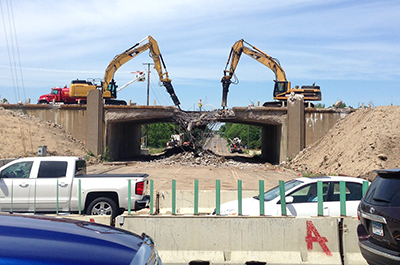
Crews demolish the Hwy 36 bridge at Lexington Avenue in Roseville. It will be replaced with two bridges that will carry eastbound and westbound traffic on Hwy 36. The work is one of more than 240 projects MnDOT is working on this season. MnDOT file photo |
The Hwy 36 bridge at Lexington Avenue in Roseville is one of more than 240 construction projects MnDOT is working on this season.
The $10 million project in the Metro District started in April and is set for completion by November 2016.
Lexington Avenue runs under the existing bridge, which will be replaced by two new bridges to carry eastbound and westbound Hwy 36 traffic. The project also includes the reconstruction and resurfacing of ramps.
The project will upgrade two signal systems at Lexington Avenue and the pedestrian crossings will comply with the American with Disabilities Act. Speakers and raised arrows on the signals provide information about the intersection to pedestrians with hearing and visual impairment.
New median high tension cable guardrail is also part of the project.
The project will increase safety and reduce congestion by improving the highway layout and ramps at Lexington Avenue. The work will also improve drainage in the area.
For more information, go to the Hwy 36 and Lexington Avenue project website. |
 |
|

|
 |
TABLE of CONTENTS
 |
Microsoft Office 2013 upgrade coming for MnDOT employees |
MN.IT Central has entered into an agreement with Microsoft to move to Government Community Cloud in 2016. To move to this new platform, the state agencies need to upgrade their Microsoft Office applications. MnDOT has selected Microsoft Office 2013 as the version that the agency will be upgrading to over the next few months.
What will change
As state agencies move to this improved platform, there will be some changes to the tools employees regularly use, such as Outlook, SharePoint and Lync (will now be called Skype for Business). MN.IT's goal is to make the transition as smooth as possible.
- Outlook (including web users) will see a new modern look and feel to email.
- If you use SharePoint, the site owner has already been contacted for what needs to be done to ensure that all content is migrated and functionality remains the same.
- Lync becomes Skype for Business. The user look and feel will be updated, but overall the functionality will remain the same.
- Word, Excel, and PowerPoint will be updated, but overall the functionality will remain the same.
For more information and training
To stay up to date, launch the IT Self Service  icon on your desktop. The website will have up-to-date project details to include: training resources, FAQ’s and service announcements.> icon on your desktop. The website will have up-to-date project details to include: training resources, FAQ’s and service announcements.> |
 |
|

|
 |
TABLE of CONTENTS
 |
What's new on the web |
Environmental Due Diligence for Property Acquisition policy
One of MnDOT’s newest policies, approved in July 2016, is the Environmental Due Diligence Evaluation for Property Acquisition. The Office of Environmental Stewardship, Environmental Investigations Unit must complete the evaluation prior to an offer to the landowner for the property acquisition. The policy includes types of property acquisitions governed by the EDD process, the legal context for environmental liability, EDD evaluation levels, and responsibilities. It replaces Technical Memo 13-12-ENV-02.
New county level bicycle maps
At the request of many bicyclists, MnDOT has now produced the first county-level bicycle maps. There are 125 maps with some counties split into more than one sheet. You can click on a county name to see trails, road conditions and more. Print the maps on 8.5x11 or 11x17 paper to take along to help navigate your trip. Go to www.mndot.gov/bike/maps.html to scope them out.
Because this is the first effort to show data at the county scale, there are gaps, and MnDOT will continue to work with the counties to improve the data and layout of these maps with future reiterations. Comments on how to improve the maps are welcome. Submit feedback to bicyclemap.dot@state.mn.us.
Pollinator website
MnDOT manages approximately 175,000 acres of green space along highways throughout Minnesota and has been working to restore native plant species along roadsides for more than 25 years. Learn more about the variety of ways MnDOT maintains these roadways to maintain the desired beneficial vegetation to support the infrastructure and the ecosystems at mndot.gov/pollinators/.
This site also includes information on the “Monarch Highway,” the Interstate 35 Corridor that sees the migration of monarchs—to and from Minnesota and Texas annually. As part of a federal strategy, signed into effect in May 2015 by President Obama, there is a goal to restore, enhance or create seven million acres of land for pollinators over the next five years.
Tribal-State Relations training
Since 2013, state agency employees have had the opportunity to learn more about Minnesota’s tribes and interact directly with key tribal members in this expert-led Tribal-State Relations Training. This ongoing program is key to improved relationships, understanding, and progress among state government agencies, mandated to consult with the tribes on matters of mutual interest.
Minnesota is home to 11 sovereign tribal nations which collectively represent the sixth-largest employer in the state and the majority of the state’s 61,000 American Indians.
To learn more about Minnesota tribes and the Tribal State Relations Training program visit the website at mndot.gov/tribaltraining/.
|
 |
|

|
 |
TABLE of CONTENTS
 |
On the Job: Meet Pat Osborn, weigh scale system investigator |
By Marcia Lochner, Freight and Commercial Vehicle Operations

Pat Osborn enjoys working on his model railroad in his free time. Photo courtesy of Pat Osborn |
Pat Osborn works as the weigh scale system investigator in the Office of Freight and Commercial Vehicle Operations. Osborn makes sure the technical designs of weight enforcement systems meet the operational needs of the State Patrol and MnDOT, and fit the available budget. He works closely on the designs with the districts and also manages consulting contracts to get the designs into the necessary format so that they can be built. This usually involves working with buyers, consulting services and the bid letting folks.
For the most part, Osborn is also the first point of contact for State Patrol for technical problems that arise at MnDOT’s weigh stations. In some cases, that results with him helping to identify the cause and, if it’s simple enough, working with them to fix the problem. Otherwise, he contacts the vendors, contractors or appropriate MnDOT staff to arrange for the repairs.
“While I can do much of the electronic systems, I rely very heavily on expertise from a large number of MnDOT units for aspects of most every project,” said Osborn. “Val Svensson and her people in the program delivery/contracting/letting world; Office of Traffic, Safety and Technology's signing and lighting staff; Jihshya Lin and others in Bridge for designs of sign structures; as well as the Electrical Services Section, traffic engineering in the districts, district design groups, and on and on. Without all of these many people pitching in we wouldn’t get anything pulled together.”
Osborn’s work doesn’t end after the planning and designing stages. He then works closely with the districts and the Central Office Program Delivery unit to move the designs forward to purchases, or lettings and awards. Finally, during the construction phase he wears the hat of the weigh station “expert.” In this role, he works with the district construction engineers and inspectors to ensure that the contractor builds the systems properly and he performs the final inspection of the technical systems in the project.
What do you enjoy most about your job?
That is hard to answer. I love the variety of areas that I get involved in. I get to talk to people in State Patrol and learn how they do their jobs so that I can try to convert their needs into real-world solutions. On the MnDOT side, I get to work with some really great people from a variety of disciplines in the concept, design, letting and construction phases. Not a day goes by where several somebodies haven’t taught me something (or at least attempted to). It’s pretty much like a big puzzle and we have all these pieces in front of us … the job is to fit those pieces together in just the right combination.
What has been your most rewarding project?
Impossible to say, at this point the stations are all still ‘works in progress,’ but it’s been real rewarding to get a lot of positive feedback on the improvements we’ve made and the ones that we are still planning.
What are you working on now?
To name a few:
- Finalizing design for the Forest Lake station. This will include a ramp weigh-in-motion and static scale, signage and ramp modifications.
- Beginning scoping and design for the Clarks Grove station (near the Minnesota-Iowa border). This will probably include a mainline WIM, static scale, signage and ramp modifications.
- Beginning construction on the scale pit and platform rehabilitation at Worthington.
- Finishing a design for scale platform replacement and pit rehabilitation at Saginaw (northwest of Duluth).
What did you do before you came to MnDOT?
I started with MnDOT originally back in the early ‘90s at the Radio Shop. I then worked on the Trilogy project (an operational test of early in-vehicle traffic information), worked at the Traffic Management Center, and helped with the design of the Regional Transportation Management Center. I left MnDOT and did some consulting and at the same time taught K-8 computer and technology for several years. During that time I also did some part-time work writing software for MnROAD, Minnesota’s pavement testing center. I’ve been back at MnDOT in OFCVO for about 1 ½ years now.
What do you do in your spare time?
I’ve been building a model railroad for several years. It started as a project with the youngest and kept going now that they are all out of the house. Now I’m waiting for my grandson to join in. I fly R/C airplanes a little, do a little amateur radio, work some on social justice issues, and this year I’ve been doing some kayaking and building a sail rig for a kayak. I’ve sailed since I was a kid and looking to do that with something that is a little easier to transport and launch than a traditional sailboat.
Do you or a co-worker have an interesting job to share with readers? Send us your ideas, and we’ll contact you for more information.
Recent employee profiles:
|
 |
|

|
 |
TABLE of CONTENTS
 |
Preventing noxious weeds from spreading takes strategy, teamwork |
By Judy Jacobs

Pretty as it is, Dalmatian Toadflax is considered a noxious weed that is damaging to pastureland and ecosystems and is notoriously difficult to control. Photo by Dave Hanson |
It was the middle of winter in Minnesota when a report came in about a new weed species that had been spotted on the North Shore. News spread quickly and within a few weeks a meeting was convened in Grand Marais to formulate a plan for strategic weed control. The infestation was growing on both public and private land but exactly how big an area it was remained unknown.
What was known was that this weed, Dalmatian Toadflax, would not be an easy target. It has been very damaging to pastureland and ecosystems in other states and is notoriously difficult to control. Experts knew weed control was going to take a coordinated response.
On the North Shore people were stepping up. The Cook County Invasives Team offered to help work with landowners. MnDOT would map and control what was growing on the roadside. The Minnesota Department of Agriculture had resources to help with monitoring and control. Both the U.S. Forest Service and the Conservation Corps of Minnesota would also be involved.
“A similar scenario had unfolded a few years earlier when Dalmatian Toadflax was found in far northwest Minnesota,” said Ken Graeve, botanist, Roadside Vegetation Management Unit with the Office of Environmental Stewardship. “In this case, a response was rallied with the involvement of local landowners, the Nature Conservancy and county and state staff. The response even included a grueling day of weed pulling by MnDOT maintenance staff, which was a heroic effort considering that at the time they were bogged down in preparations for a looming government shutdown.”
Why was such a big deal made of a few small patches of weeds?
It seems counterintuitive—the typical reaction would be to ignore such a small infestation and try to control the more obvious problems, such as Common Tansy in the northeast or Canada Thistle statewide. But invasive species can be thought of as a slow-moving wildfire. Both can cause serious damage as they spread across the landscape.
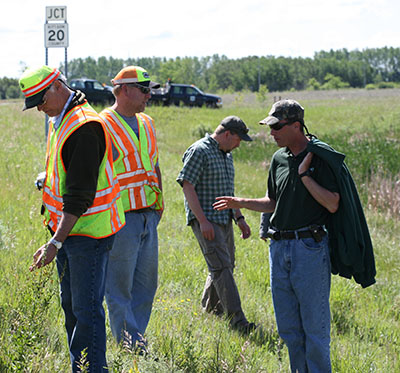
MnDOT employees worked in a partnership with the Minnesota Department of Agriculture and The Nature Conservancy to stop the spread of a new noxious weed species. Photo by Dave Hanson |
“Trying to control a widespread, well-established invasive species is like trying to put out a massive wildfire—both will be very difficult to control and in each case the damage has already been done,” Graeve said. “As wildland firefighters have long known, it is much easier to control a problem while it is small, and this relatively small effort will prevent vast amounts of damage.”
With limited resources for weed control, it is important for roadside managers to determine which weeds are “massive wildfires” and which are the isolated and more manageable “spot fires.”
Prioritization varies by region. In northeastern Minnesota, Toadflax is a high priority while Common Tansy is widespread. A few days of work on the Toadflax can have immense payoffs in preventing future work and ecosystem damage, whereas a month's worth of work on Common Tansy would barely scratch the surface. In northwest Minnesota, Toadflax is a much higher priority than the common Spotted Knapweed. While in southeast Minnesota controlling the isolated patches of Teasel or Japanese Hops has far more benefit than getting lost in the caustic thickets of Wild Parsnip.
This strategic approach to weed control is much less obvious. Like a midwinter meeting to coordinate a Dalmatian Toadflax response, it probably will not be noticed by most. Travelers might drive past miles of Common Tansy or Canada Thistle and wonder why they aren't seeing much control. Most travelers don't stop to consider why they aren't seeing Dalmatian Toadflax running rampant.
“It is hard to notice the absence of a problem, but that shouldn't diminish the importance of the work that goes into preventing such a problem,” Graeve said. “Prioritizing efforts on the high-risk weed infestations can help to use resources more efficiently and greatly reduce future impacts from these emerging invasive species.”
For a complete list of Minnesota noxious weeds visit www.mndot.gov/roadsides/vegetation/vegetation.html.
|
 |
|

|
 |
TABLE of CONTENTS
 |
Three MnDOT programs recognized for their creativity, innovation |
By Judy Jacobs
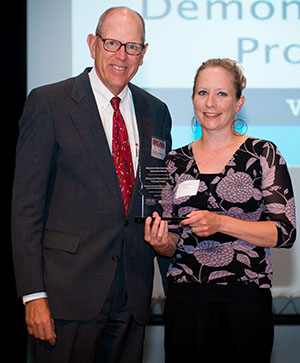
From the Office of Aeronautics, Jennifer Zink, state bridge inspection engineer, accepted the award from Jay Kiedrowski, Humphrey Schools. The Unmanned Aircraft System project was funded through the Office of Transportation System Management research program and the contract managed by Bruce Holdhusen. Photo courtesy of SP Foley Photography |
MnDOT was one of 10 state agencies July 21 that received State Government Innovation Awards for creative work and projects.
The Humphrey School of Public Affairs, in partnership with the Bush Foundation, presented the awards to recognize the great work of government entities and to encourage an environment that allows agencies to deliver better government services to Minnesotans through creativity, collaboration and efficiency.
MnDOT programs and initiatives received three awards:
- Office of Aeronautics - Unmanned Aircraft Systems Bridge Inspection Demonstration Project – MnDOT found that using Unmanned Aircraft Systems for bridge inspections decreases safety risks, provides less disruption to traffic and reduces work time.
- Office of Government Affairs - Government-to-Government Tribal-State Relations Training Program – This training is a unique collaboration with the state, the University of Minnesota-Duluth and the 11 Minnesota Tribal Nations to share knowledge to provide a better understanding and respect to create a more positive dialogue resulting in decisions that can benefit Minnesota Indian communities and Minnesota as a whole.
- Office of Transportation System Management - Statewide Multimodal Transportation Plan and State Highway Investment Plan – This public engagement effort included several innovative tools and techniques, including live cell phone polling, roving iPad surveys at community events and the MinnesotaGO mobile that doubled as a life-size coloring book.
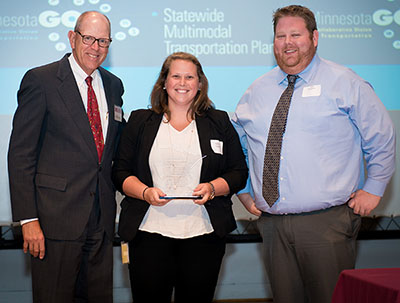
Katie Caskey and Josh Pearson, planning program coordinators, Office of Transportation System Management, accept a state government innovation award from Jay Kiedrowski, Humphrey Schools, on behalf of all team members who contributed to the MnSHIP and SMTP public input process. Photo courtesy of SP Foley Photography |
Other state agencies receiving awards include:
- Department of Labor and Industry – Minnesota Pipeline Project
- Department of Military Affairs – Minnesota National Guard, Camp Ripley Sentinel Landscape
- Minnesota Pollution Control Agency – Green Step Cities
- Minnesota Veteran’s Home Adult Day Center – Operation Sight and Sound
- Department of Natural Resources – Parks and Trails Division, ParkFinder
- Minnesota Management and Budget – Employee Diabetes Prevention Program
- Minnesota Pollution Control Agency – 12st Avenue West Aquatic Habitat Restoration
“These state agencies demonstrate exceptional innovation within their organization,” said Jay Kiedrowski, senior fellow at the Humphrey School who served as master of ceremonies for the award program. “We hope these awards will encourage an environment of experimentation and creativity throughout state government.”
Linda Aitken, Office of Government Affairs, accepted the award for the Tribal-State Relations Training Program.
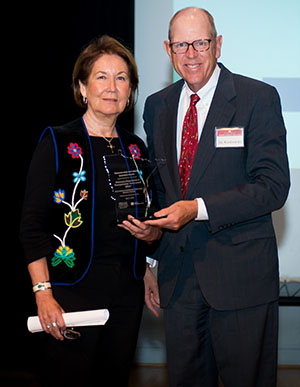
Linda Aitken, Tribal-State Training program manager, accepted the award from Jay Kiedrowski, Humphrey Schools, for her team. Photo courtesy of SP Foley Photography |
“Miigwech. Thank you. This is truly an honor,” she said. “Our agency is proud of the Tribal-State Relations Training and the tremendous response we have had from all state agencies. We have trained approximately 1,400 state employees in the three years the program has been in existence. Feedback from employees has been extremely positive. It’s been an amazing opportunity for us to partner with the Minnesota Tribal Nations and the University of Minnesota-Duluth and other state agencies to build cultural awareness across the state.”
The SGIA program began three years ago and was inspired by the Humphrey School’s annual Local Government Innovation Awards program that recognizes schools, cities, townships and counties for their creative programs and projects.
For more information on the State Government Innovation Award program and to see a complete list of the award recipients, visit State Government Innovative Awards. |
 |
|

|
 |
TABLE of CONTENTS
 |
WIG 2.0: Earning customer trust |
By Tracy Hatch, deputy commissioner, chief operating officer and chief financial officer
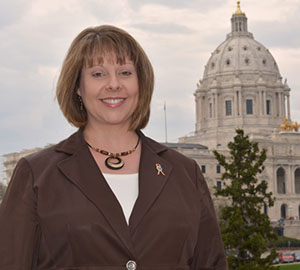
Tracy Hatch is MnDOT's deputy commissioner, chief operating officer and chief financial officer. With the newly launched WIG 2.0, she challenges employees to see and think about their work from the customer’s perspective. Photo by Rich Kemp |
This week we launch WIG 2.0. This is an exciting time for MnDOT as we work together over the next two years to earn customer trust. Our desired outcome of WIG 2.0 is that MnDOT will earn trust and increase transparency through a customer-centered organization in which we engage customers, listen to understand and balance the diverse needs of all to achieve the best possible outcomes.
Customer trust is internal and external; it challenges all of us to pivot from a “Producer” viewpoint to a “Customer” viewpoint – we all need to challenge ourselves to really look at what, and how, we think about the work we do from the customer’s perspective.
This doesn’t mean we will automatically give our customers what they want, or make them happy all the time, but we should take the time to understand their needs and what’s important to them. Then we can evaluate if/how we can meet their needs.
We selected our two priority areas of Advancing Equity and Improving Intentional Customer Engagement, not because they are the only way we can earn trust, but because these are two areas where we receive the most criticism from stakeholders. There will naturally be a lot of crossover between the two priorities.
We have structured the launch for WIG 2.0 to help ensure all staff begin their work with a shared understanding of what we are trying to achieve and definitions of key terms involved with these goals. If your workgroups would prefer to work ahead and complete all the steps included in the launch, please feel free to do so! This will look familiar, as this is similar to how we worked through WIG 2.0 Development Assignments.
We are excited to start working together to create a more diverse and inclusive work environment and implement best practices to create a customer-centered culture. Creating a way to measure what is working, and where we have opportunities to improve will allow us to share our best practices and seek out new solutions to help us consistently focus on our customers.
For more information visit: WIG 2.0 on iHub or contact: *DOT_WIG or your Local Coach
Let’s get started! |
 |
|
| |
|



